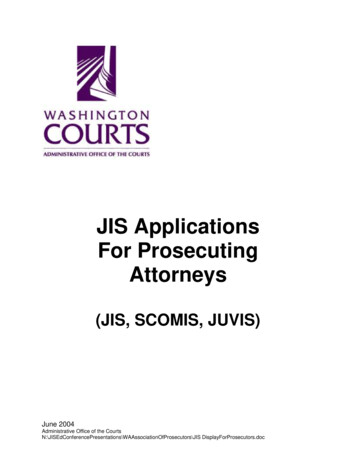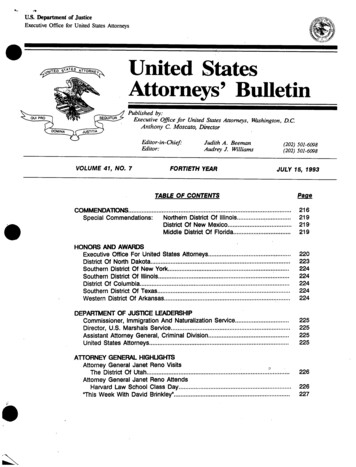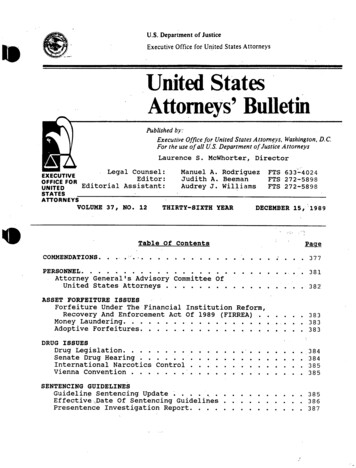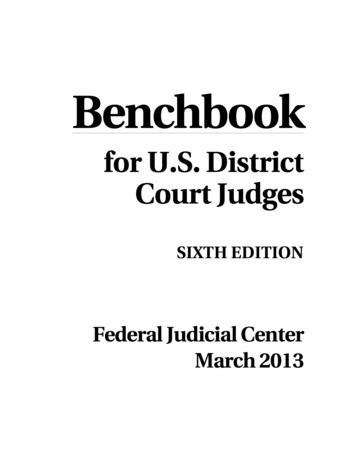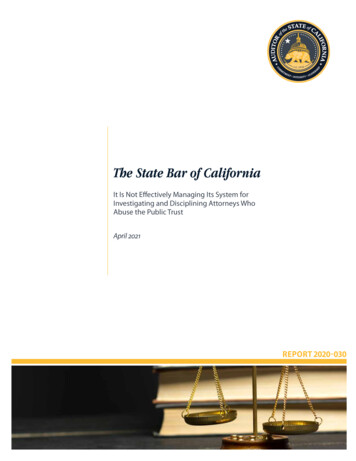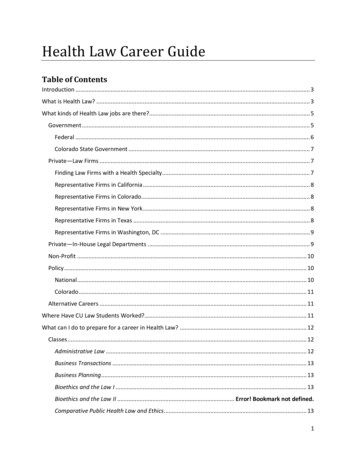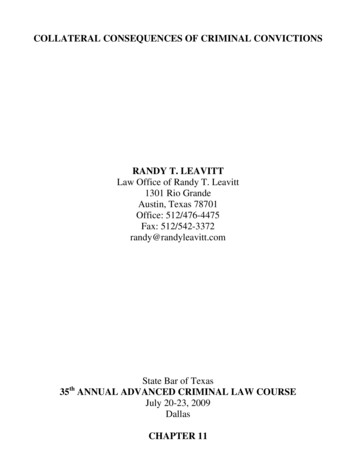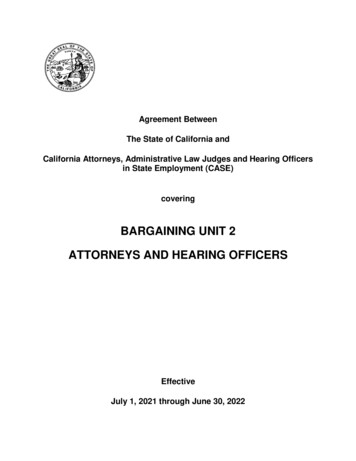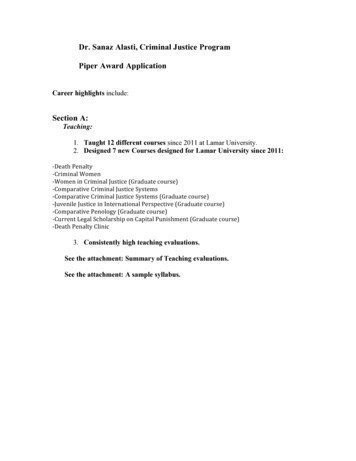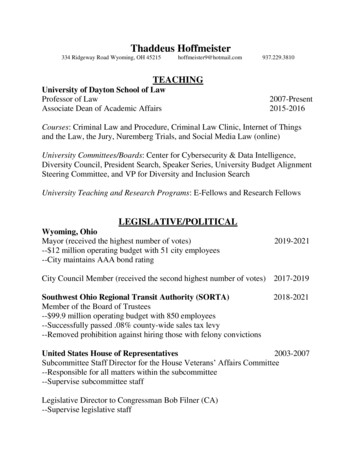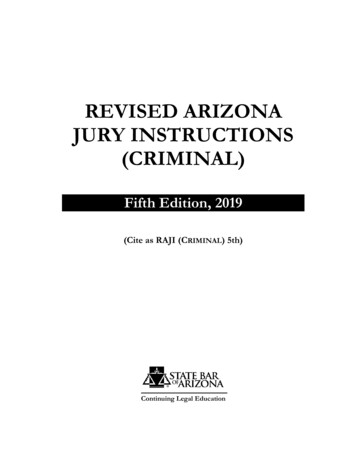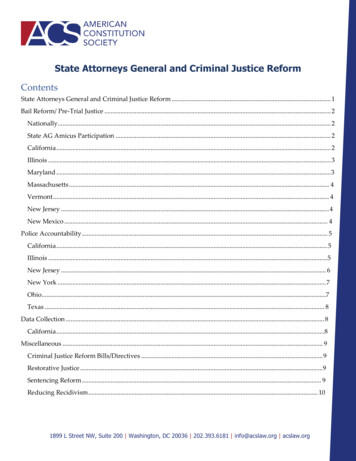
Transcription
State Attorneys General and Criminal Justice ReformContentsState Attorneys General and Criminal Justice Reform . 1Bail Reform/ Pre-Trial Justice . 2Nationally . 2State AG Amicus Participation . 2California . 2Illinois . 3Maryland . 3Massachusetts . 4Vermont . 4New Jersey . 4New Mexico . 4Police Accountability . 5California . 5Illinois .5New Jersey . 6New York . 7Ohio .7Texas . 8Data Collection . 8California .8Miscellaneous . 9Criminal Justice Reform Bills/Directives . 9Restorative Justice .9Sentencing Reform . 9Reducing Recidivism . 101899 L Street NW, Suite 200 Washington, DC 20036 202.393.6181 info@acslaw.org acslaw.org
Bail Reform/ Pre-Trial JusticeNationallyNational Conference of State Legislatures, Trends in Pretrial Release: State Legislation (last updated April 1,2018). “Since 2012, every state legislature has addressed pretrial policy, resulting in close to 700 newenactments. The report "Trends in Pretrial Release: State Legislation" highlights legislative actionbetween 2012 and 2014. Enactments from this time period have individualized the pretrial process byfocusing on specific defendants or offense categories.”Vera Institute, A Breakthrough Year on Bail Reform (2017). Vera Institute Resource highlights the bail reform efforts by states and municipalities, including recentlegislation, newest initiatives and general facts and figures.Civil Rights Corps, Ending Wealth based Pretrial Detention. Information and resources on successful class actions lawsuits brought by the organization, challengingmoney bail in several jurisdictions across the country.State AG Amicus ParticipationBrief Of Amici Curiae Current And Former District And State’s Attorneys, State Attorneys General, UnitedStates Attorneys, Assistant United States Attorneys, And Department Of Justice Officials, In Support OfPlaintiffs-Appellees, Miranda Lynn O’Donnell v. Harris County, Texas, et. al., No. 17-20333 (5th Cir. 2018). Nearly 70 current and former law-enforcement officials from more than 30 states participated as amici.Fifth Circuit upheld trial court’s historic decision that found Harris County bail system violative of dueprocess and equal protection rights for indigent individuals arrested for misdemeanor offenses. CivilRights Corps served as co-counsel in this case.CaliforniaAlexi Kossef, California’s bail system doesn’t make us safer, attorney general says, The Sacramento Bee (Feb.20, 2018). California Attorney General Xavier Becerra declined to appeal a recent court decision on excessivebail, lending his support to a “growing statewide push to overhaul a money bail system that criminaljustice advocates argue is discriminatory to poor Californians.”2
In re KENNETH HUMPHREY, on Habeas Corpus A152056 (Ct. App. 1st 2018). California Court of Appeals decision reversing trial court’s bail determination and remanding forfurther proceedings. Civil Rights Corps served as co-counsel for Petitioner Kenneth Humphrey.IllinoisIllinois courts adjusting to state’s new bail reform law, Seattle Times (Feb. 12, 2018). The new Illinois Bail Reform Act, which went into effect January 1, 2018, requires a lawyer to bepresent at the initial court appearance for anyone arrested, and aims to release defendants facing nonviolent misdemeanors or low-level felonies without requiring them to post cash bail if they don’t pose areasonable threat to the community and are unlikely to flee.MarylandScott Dance, Since bail reform, Maryland holding fewer people who can't afford bond, Assembly panel told,The Baltimore Sun (January 16, 2018). “ about one-fifth of defendants are being held because they can’t or don’t pay bail, down from 40percent in the months before the reforms were enacted, Judge John P. Morrissey, chief judge of theDistrict Court of Maryland, said Tuesday. About 53 percent of those who appear before a bailcommissioner are released from custody, up from 44 percent before the reforms ”Michael Dresser, Frosh warns that bond industry-supported bail bill undoes Maryland court's rule, TheBaltimore Sun (March 14, 2017). AG Brian Frosh defended a Maryland Court of Appeals rule (against legislation in the MarylandGeneral Assembly backed by the bail bond industry) that “requires judges and court commissioners totake into account a defendant's ability to afford bail when setting the terms for pretrial release,” toprevent undue hardship and disproportionate prison time for defendants in poverty. Frosh also issuedan opinion last year questioning the constitutionality of keeping prisoners in jail when they can't affordbail.Advancing Bail Reform in Maryland: Progress and Possibilities, Woodrow Wilson School of Public andInternational Studies, Princeton University (Revised, Feb. 26, 2018). A report detailing both Maryland’s recent bail regime, the reform effort and key recommendations toensure lasting progress.Ovetta Wiggins, Md. attorney general’s office raises constitutionality questions about state’s cash bail3
system, Washington Post (Oct. 11, 2016). Maryland OAG issued an opinion (written by Sandra Benson Brantley, counsel to the GeneralAssembly) that the current system of setting bail could violate due process, bolstering the efforts of agroup of Maryland lawmakers to abolish cash bail for poor defendants.Maryland Attorney General’s Bail System Reform FAQ This Q&A about bail system reform is hosted on the Maryland OAG website. It includes a letter fromAttorney General Brian Frosh to the Maryland Standing Committee of Rules of Practice and Procedure,requesting changes to Maryland Rule 4-216 on pretrial release.MassachusettsKatie Lannan, A broad push for pretrial justice reforms from the states, Boston Globe (Aug. 8, 2017). Attorney General Maura Healey favors eliminating detentions based solely on someone’s inability topost bail.VermontMark Johnson, Donovan pushes bail reform in interest of fairness, economic equity, VTDigger.com (Jan. 10,2018). Vermont Attorney General TJ Donovan urged lawmakers to reform the state’s bail statutes by cappingthe amount for certain nonviolent misdemeanor crimes. His reasoning is that this would allow agreater number of lower-income people a chance to be released before trial and would also provideuniformity in pre-trial justice by reducing judicial discretion.New JerseyAttorney General Law Enforcement Directive No. 2016-6 v.2.0 – Modification of Directive Establishing InterimPolicies, Practices, and Procedures to Implement Criminal Justice Reform Pursuant to P.L. 2014, c. 31. An Attorney General Law Enforcement Directive detailing the overhaul of Criminal Justice Reform inNJ; it declared one of its overarching goals to be ensuring that “low-risk, indigent defendants are notbeing incarcerated on low money bails that they cannot pay.”New MexicoNew Mexico Dispute Over Bail Reform Escalates in Court, US News and World Reports (Sept. 25, 2017).4
New Mexico Attorney General Hector Balderas fought back against a lawsuit from the Bail BondAssociation of New Mexico and several state lawmakers that sought to block new rules governing pretrial release of defendants, calling it frivolous and asking a federal court to sanction the plaintiffs'attorneys.Police AccountabilityCaliforniaDale Kasler and Benji Egel, California AG to oversee investigation into fatal police shooting of StephonClark, The Sacremento Bee (March 27, 2018). California DOJ is providing independent oversight of current investigation into shooting death ofStephon Clark.Press Release, California Department of Justice, Attorney General Becerra Takes On Independent Review ofSan Francisco Police Reforms (Feb. 5, 2018). The California Department of Justice, led by AG Becerra, “entered into an agreement with the City ofSan Francisco (City) and San Francisco Police Department (SFPD) to evaluate and publicly report onthe police department’s implementation of reforms previously recommended by the U.S. Departmentof Justice (USDOJ).” The OAG is stepping into a vacuum left by U.S. Attorney General Jeff Sessions and the USDOJ afterthey abandoned collaborative police reform efforts overseen by the federal Office of CommunityOriented Policing Services (COPS) in San Francisco and throughout the nation. "When local law enforcement agencies reach out for support, the last thing our federal governmentshould do is abandon them,” said Attorney General Becerra.IllinoisBill Rutthart, Anne Sweeney and John Byrne, AG Madigan sues to enforce Chicago police reform; Emanuelpledges cooperation, Chicago Tribune (Aug. 30, 2017). Attorney General Madigan sued the city of Chicago “contending Mayor Rahm Emanuel's reforms arenot sufficient to prevent the Chicago Police Department from continuing a pattern of deadly andexcessive force that disproportionately hurts African-Americans and Latinos.” Madigan filed thelawsuit based on the findings of the federal Justice Department investigation into the city of Chicagopolice form, and named deficiencies including inadequate training, a lack of supervision and "afailure to investigate misconduct and discipline officers."5
Results: Mayor Emanuel was forced to accept a federal judge’s oversight of the Police Department Will likely inspire increased reforms – beyond those already put in place by his administration Madigan also critiqued Emanuel’s efforts to negotiate with Trump’s administration “which hassignaled a general opposition to court oversight of police departments” and which Madigan said,“fundamentally does not agree with the need for constitutional policing."Additional Resources: State of Illinois v City of Chicago ComplaintIllinois Attorney General website - Chicago Police Consent DecreeNew JerseyAttorney General Law Enforcement Directive 2018-1 – Law Enforcement Directive Concerning Public Releaseof Video Recording Depicting Police Deadly Force Incidents. Attorney General Gurbir S. Grewal issued an Attorney General Law Enforcement Directive instructingthat law enforcement would make publicly available footage from body-worn cameras and patrolvehicle dashboard-mounted cameras in any case involving police use of deadly force.Attorney General Law Enforcement Directive No. 2018-3 – Statewide Mandatory Early Warning Systems. An Attorney General Law Enforcement Directive mandating that all law enforcement agencies in NewJersey adopt and implement Early Warning (“EW”) Systems, which are “designed to detect patternsand trends in police conduct before that conduct escalates,” allowing the law enforcement agency toidentify and address all officer conduct that poses potential risk to public safety and agency integrity.New Jersey Attorney General’s Office Website -- How New Jersey Ensures Independent Investigations ofOfficer-Involved Shootings (last visited, June 5, 2018). Website provides information on AG guidelines for law enforcement officials on how to investigatepolice involved shootings. “In 2015, the New Jersey Attorney General issued the ‘IndependentProsecutor Directive,’ establishing a process to ensure that officer-involved shootings be investigatedfully, fairly, and independently of any potential bias. The Directive applies to any discharge of afirearm by a law enforcement officer in the course of his or her duties, regardless of whether theshooting resulted in death.”NJ attorney general mandates outreach to understand probe of police shootings, NJTV News.com (May 31,2018). Article discusses how Gloucester County, NJ law enforcement officials are inviting members of the6
public to training sessions to demonstrate how police departments around the state must follow stateattorneys general guidelines for fatal police-involved shootings.New YorkNew York Attorney General's Special Investigations and Prosecutions Unit website. This website contains information on SIP's mandate and all investigation reports, including its firstbiennial report. "On July 8, 2015, Governor Cuomo issued Executive Order No. 147, which appointedthe New York State Attorney General as special prosecutor in incidents where a law enforcementofficer causes the death of an unarmed civilian, or where there is a significant question as to whetherthe civilian was armed and dangerous. The following day, the office announced the creation of theSpecial Investigations and Prosecutions Unit (SIPU), led by Executive Deputy Attorney General AlvinBragg, to investigate and, if warranted, prosecute all cases that fall within the scope of Executive Order147."Troy City Council meets with State Attorney General's office on police reform, wnyt.com (Albany, NY) (Mar.10, 2018). NY OAG met with Troy, NY City Council members to discuss implementing new safety policies andprocedures after the State Attorney General's office issued a report regarding the police shooting deathof 37-year-old Edson Thevenin during a Troy traffic stop in April of 2016. The OAG did not find theTroy Police Department criminal responsible but called for changes, including the installation of bodyand dashboard cameras for police. See, Troy activists want review board, Albany Times Union, (Jan. 19, 2018).Press Release, New York Attorney General, A.G. Schneiderman Announces Indictment Charging RensselaerCounty DA Joel Abelove With Official Misconduct And Perjury, (Dec. 1, 2017). Grand Jury charged Rensselaer County District Attorney Joel Abelove with two counts of officialmisconduct and one count of perjury in the first degree. “The charges stemmed from Abelove’shandling of the April 2016 death of Edson Thevenin, a civilian who was shot and killed during anencounter with Troy police.” See, When the People’s Lawyer Breaks the Law – Editorial, New York Times, (Dec. 13, 2017).OhioRandy Ludlow, Task force: Attorney general should handle fatal police use of force cases, The ColumbusDispatch (July 13, 2016).7
Ohio Attorney General Investigation – Officer Involved Shooting of Timothy Russell and Malissa Williams(Feb. 5, 2013). Attorney General Mark DeWine stated that a November 2012 police chase that ended with the fatalshooting of two suspects revealed a "systemic failure" of the Cleveland police department, citingboth individual policy violations by police officers and the failure of their communications andcommand system to provide adequate structure and support. He later stated that, “People inleadership need to take responsibility. The police department system failed these officers andthey failed the general public. You can’t look at that report and come up with any otherconclusion,” after Police Chief Michael McGrath responded to DeWine's assertions at a later CityHall press conference saying there was no "systematic failure.”TexasTexas Attorney General’s Office – Peace Officer Involved Shooting Reports The Office of the Attorney General (OAG) adopted and published reporting forms for Officer-InvolvedShooting Incidents, as required by Articles 2.139 and 2.1395 of the Code of Criminal Procedure, whichbecame effective September 1, 2015.Data CollectionCaliforniaCriminal Justice Statistics Center. According to the site, "The California Attorney General has the duty to collect, analyze, and reportstatistical data, which provide valid measures of crime and the criminal justice process to governmentand the citizens of California. The mandate of the Criminal Justice Statistics Center (CJSC) is to collectand report statistical data that allow for valid assessments of crime and the criminal justice process inCalifornia. This site contains crime data submitted by county and local law enforcement agencies, aswell as current and historical publications on crime, juvenile justice, homicide, and hate crimes inCalifornia."California DOJ Open Justice Website. Open Justice is “a transparency initiative led by the California Department of Justice that publishescriminal justice data so we can understand how we are doing, hold ourselves accountable andimprove policy to make California safer.” It includes information and data trends regarding firearmsales, arrests, hate crimes, deaths in custody, use of force, and more in in the California criminaljustice system.8
MiscellaneousCriminal Justice Reform Bills/Directives[Massachusetts] Gov. Charlie Baker signs landmark Massachusetts criminal justice overhaul, despite concerns,MassLive.com (April 13, 2018). Massachusetts Attorney General Maura Healey supported Governor Charlie Baker’s signing of acriminal justice reform bill that creates major policy changes in the Massachusetts criminal justicesystem, including improving jails, diverting more individuals into treatment and programming, andimproving the reentry process of inmates into society. Healey called the bill a "landmark" piece oflegislation. "This is about putting justice in our criminal justice system and getting it right," Healeysaid. See also, 7 Key Provisions Of The Criminal Justice Bill, WBUR.com (April 6, 2018).[New Jersey] Attorney General Law Enforcement Directive No. 2018-2 – Statewide Mandatory Random DrugTesting. An Attorney General Law Enforcement Directive expands the existing AG Testing Policy for testinglaw enforcement officers for illegal drug use to include a random drug testing component. Theprevious policy already required the testing of applicants and trainees for law enforcement positions aswell as current officers for whom reasonable suspicion existed that they were using drugs illegally.Restorative Justice[Washington D.C.] D.C. OAG's Restorative Justice Program Attorney General Karl Racine launched this program in 2016 “to address the root problems of crimeand conflict, and offer juvenile prosecutors an alternative to traditional prosecution." The D.C. OAG isthe first public safety agency to implement an “in-house” restorative justice program in whichrestorative justice specialists work alongside prosecutors. Over 80 percent of youth who havecompleted the program have not subsequently been re-arrested.Sentencing Reform[Delaware] Press Release, Delaware Governor’s Office, Markell Signs Mandatory Sentencing Reform intoLaw (July 20, 2016). Former Delaware Governor Jack Markell signed legislation into law reforming Delaware’s habitualoffender law, eliminating mandatory life sentences for drug offenders and providing judges with9
more discretion for sentencing non-violent offenders. Delaware Attorney General Matt Dennproposed many of these changes back in 2015.[Georgia] National Association of Attorneys General (NAAG) Annual Meeting (2016). Video of former Georgia Attorney General Sam Olens discussing his offices efforts to push sentencingreform in Georgia.[Georgia and Maryland] Aleph Institute Summit Prison Sentencing Laws featuring former Georgia AttorneyGeneral Sam Olens and Maryland Attorney General Brian Frosh (Mar. 2016). Video of Aleph Institute conference featuring former Georgia Attorney General Sam Olens andMaryland Attorney General Brian Frosh. The session highlights the bipartisan nature of state criminaljustice reform efforts. Items discussed include sentencing reform, drug treatment diversion programsand bail, fines and fees.Reducing Recidivism[Pennsylvania] Philly should look west for criminal justice reform ideas Editorial, Philadelphia Inquirer(June 5, 2018). Pennsylvania Attorney General Josh Shapiro told Philadelphia elected officials and activists that toimprove its efforts to reduce the city’s imprisoned population, they should look to programs inAllegheny County in Western Pennsylvania that help incarcerated people avoid recidivism andcontribute to society through job training and placement. Shapiro specifically cited AlleghenyCounty’s Community Resource Centers (CRCs), which are often called “one-stop shops” for reentryservices. At these CRCs, people can check in with a probation officer, take a court-ordered drug test,enroll for counseling or courses, and speak with a job placement service.10
Illinois courts adjusting to state's new bail reform law, Seattle Times (Feb. 12, 2018). The new Illinois Bail Reform Act, which went into effect January 1, 2018, requires a lawyer to be . Policies, Practices, and Procedures to Implement Criminal Justice Reform Pursuant to P.L. 2014, c. 31.

